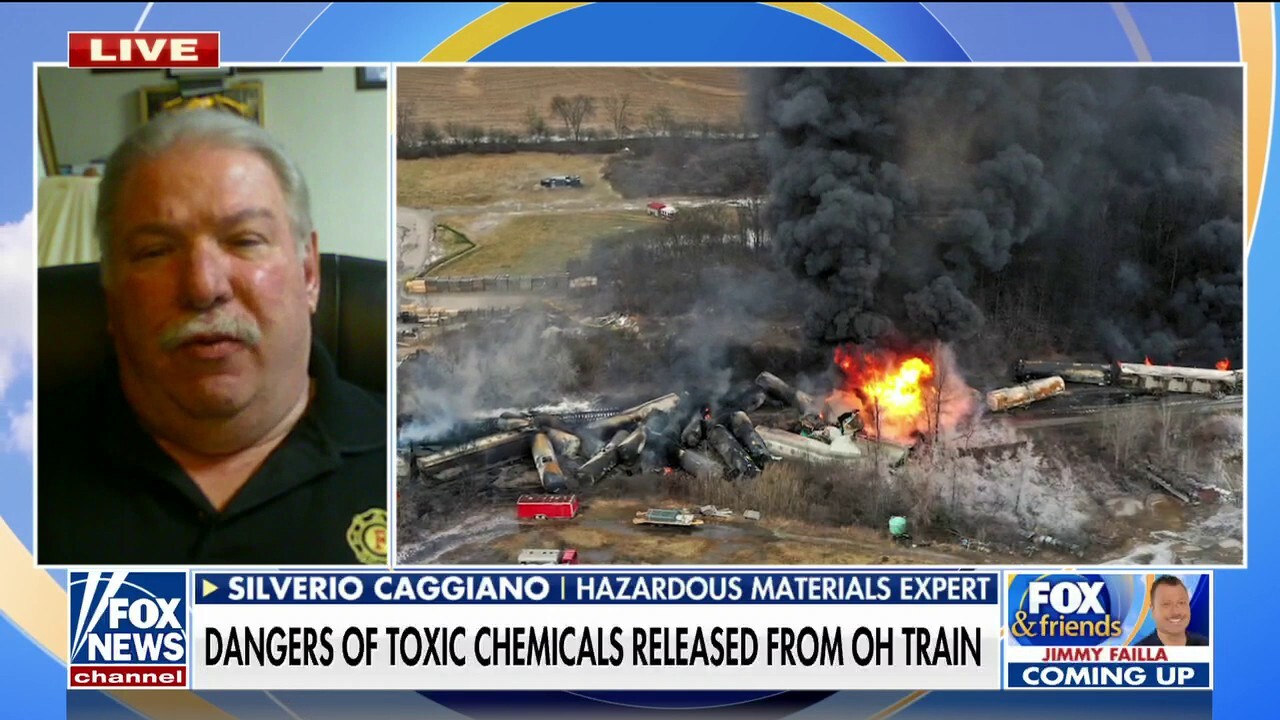Ohio Train Derailment: Lingering Toxic Chemicals In Buildings

Table of Contents
Evidence of Lingering Toxic Chemicals
The Ohio train derailment spilled a cocktail of hazardous substances, with some possessing the potential for long-term environmental and health impacts. The presence of these chemicals in and around buildings near the derailment site necessitates a thorough investigation into the extent of contamination and its implications.
Vinyl Chloride Contamination
Vinyl chloride, a known human carcinogen, was among the chemicals released in significant quantities. This volatile organic compound (VOC) readily disperses in the air and can potentially permeate building materials.
- Affected Buildings: Residential homes, commercial buildings, and even schools located within a certain radius of the derailment site are suspected of containing residual vinyl chloride.
- Testing Methodologies: Air quality testing, soil sampling, and potentially even material testing (e.g., analyzing building materials for absorbed vinyl chloride) have been employed to assess the extent of contamination. However, the consistency and comprehensiveness of these tests are currently under scrutiny.
- Levels of Detection: While some initial readings showed elevated levels of vinyl chloride, the persistence of these elevated levels within buildings over time requires further investigation. Publicly released data often lags, hindering a complete understanding of the situation.
- Health Risks: Long-term exposure to vinyl chloride is linked to an increased risk of liver cancer, brain cancer, and other serious health problems. Even low-level exposure over extended periods poses a health concern.
Other Hazardous Materials
Beyond vinyl chloride, other hazardous materials released during the derailment include butyl acrylate, ethylene glycol monobutyl ether, and various other chemicals. Each poses unique health risks and potential pathways for contamination.
- Other Chemicals and Health Effects: Butyl acrylate, for instance, can irritate the skin, eyes, and respiratory system, while ethylene glycol monobutyl ether is linked to kidney and liver damage. The long-term combined effects of exposure to multiple chemicals remain largely unknown.
- Contamination Pathways: These chemicals can contaminate buildings through various pathways: air infiltration (volatile compounds), soil contamination (affecting building foundations and potentially groundwater), and even through direct contact with spilled materials.
- Persistence in Building Materials: Porous building materials like wood, drywall, and carpeting can readily absorb these chemicals, leading to persistent contamination and potential long-term off-gassing. This makes remediation incredibly challenging and expensive.
Impact on Building Materials
The interaction between the released chemicals and building materials is a critical aspect of assessing the long-term impact of the Ohio train derailment.
- Absorption and Leaching: Many building materials can absorb these chemicals, acting as reservoirs of contamination. Over time, these chemicals may leach out, causing continued exposure for building occupants.
- Off-Gassing: The slow release of absorbed chemicals into the air (off-gassing) can expose residents to potentially harmful levels for extended periods. This is particularly concerning for volatile organic compounds.
- Remediation Challenges: Removing contamination from building materials is complex and potentially very costly. The effectiveness of different remediation techniques needs thorough evaluation and testing.
Health Concerns Related to Long-Term Exposure
The potential health consequences of prolonged exposure to the lingering toxic chemicals are deeply concerning. The lack of comprehensive, long-term studies following similar events presents significant challenges in understanding the full extent of the risk.
Respiratory Issues
Respiratory problems are a primary concern due to the inhalation of airborne contaminants.
- Respiratory Conditions: Asthma, bronchitis, chronic obstructive pulmonary disease (COPD), and other respiratory illnesses can be exacerbated or triggered by exposure to these chemicals.
- Symptoms: Symptoms can range from mild irritation (coughing, sneezing, shortness of breath) to severe respiratory distress.
- Vulnerable Populations: Children, the elderly, and individuals with pre-existing respiratory conditions are particularly vulnerable to the adverse effects.
Other Health Impacts
The health consequences extend beyond respiratory issues.
- Neurological Effects: Some of the chemicals involved can affect the nervous system, potentially leading to neurological disorders.
- Reproductive Issues: Exposure to certain chemicals can negatively impact reproductive health.
- Cancer Risks: The carcinogenic potential of some chemicals highlights the long-term cancer risk for exposed individuals.
- Other Long-Term Problems: Other long-term health effects, including immune system dysfunction and cardiovascular problems, cannot be ruled out.
Lack of Comprehensive Testing and Data
A significant challenge lies in the limited availability of comprehensive testing and long-term health data.
- Need for Independent Verification: More independent testing and analysis are necessary to fully assess the extent of contamination and its long-term effects.
- Long-Term Monitoring: Long-term health monitoring of residents in affected areas is crucial to track potential health problems and establish a clear link to the chemical exposure.
- Data Transparency: Open and transparent data sharing by government agencies and relevant organizations is essential to build public trust and inform effective response strategies.
Government Response and Ongoing Investigations
The government response to the Ohio train derailment and its aftermath has been a focal point of public attention and scrutiny.
Regulatory Actions
Government agencies at the local, state, and federal levels have undertaken various actions.
- Cleanup Efforts: Cleanup efforts have been initiated, but their effectiveness in addressing long-term contamination remains to be seen.
- Testing Programs: Government-sponsored testing programs are underway, but their scope and comprehensiveness have been questioned.
- Regulations: New regulations or stricter enforcement of existing regulations related to hazardous material transport and safety might be implemented.
Legal Ramifications
The derailment is expected to trigger various legal actions.
- Liability Issues: The railroad company and other involved entities may face significant liability for the damages and health consequences resulting from the derailment.
- Lawsuits: Lawsuits from affected residents and communities are likely, aiming to secure compensation for damages and medical expenses.
Conclusion
The Ohio train derailment's impact extends far beyond the initial emergency response. Lingering toxic chemicals in buildings pose a significant and ongoing threat to the health and well-being of the community. The lack of comprehensive testing, coupled with the potential for long-term health consequences, underscores the urgent need for continued investigation, thorough remediation efforts, and transparent communication from relevant authorities. We must demand accountability and ensure that the long-term impacts of this Ohio train derailment toxic chemicals disaster are properly addressed. Stay informed about the latest developments and advocate for the health and safety of those affected. Demand answers and action regarding the lingering threat of Ohio train derailment toxic chemicals in your community.

Featured Posts
-
 Nothing Phone 2 Reinventing The Rules Of Smartphone Design
Apr 30, 2025
Nothing Phone 2 Reinventing The Rules Of Smartphone Design
Apr 30, 2025 -
 Lich Thi Dau Vong Chung Ket Giai Bong Da Thaco Cup 2025
Apr 30, 2025
Lich Thi Dau Vong Chung Ket Giai Bong Da Thaco Cup 2025
Apr 30, 2025 -
 Activision Blizzard Acquisition Ftcs Appeal Explained
Apr 30, 2025
Activision Blizzard Acquisition Ftcs Appeal Explained
Apr 30, 2025 -
 Kynyda Ke Eam Antkhabat 2024 Tyarywn Ka Jayzh
Apr 30, 2025
Kynyda Ke Eam Antkhabat 2024 Tyarywn Ka Jayzh
Apr 30, 2025 -
 San Diego Jail Death Family Claims Hours Of Torture No Intervention
Apr 30, 2025
San Diego Jail Death Family Claims Hours Of Torture No Intervention
Apr 30, 2025
